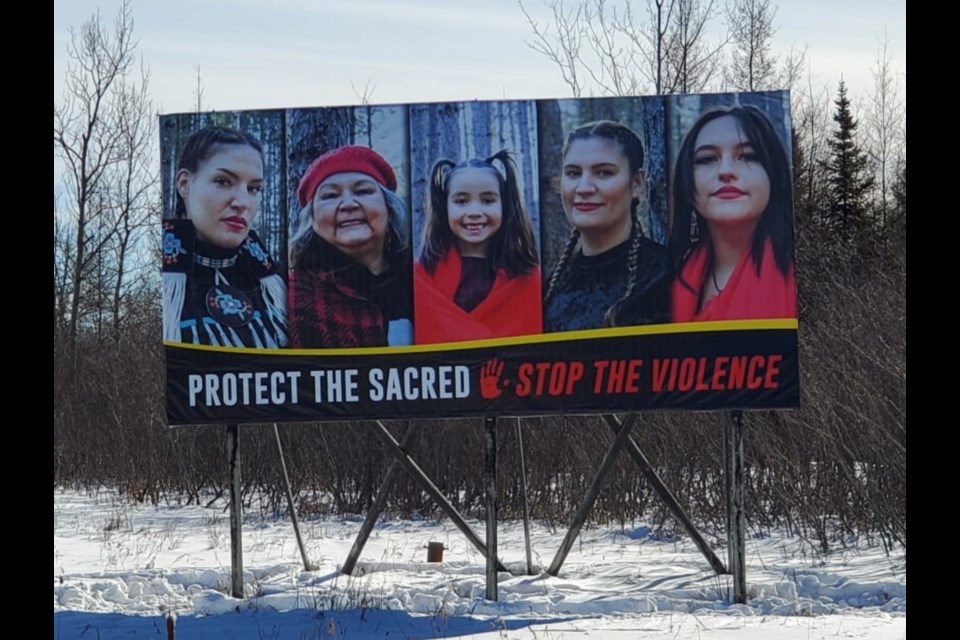A pair of new billboards along Highway 17 outside of Sault Ste. Marie intended to shed light on violence against Indigenous women are the result of one collective effort to raise awareness in the region.
The Indigenous Women’s Anti-Violence Task Force (IWAVTF) of Baawaating - a grassroots collective of Indigenous women from agencies and organizations that are mandated to provide services to Indigenous peoples - rolled out a number of projects in February, including an online version of the annual Murdered Missing Indigenous Women, Girls and 2 Spirit (MMIWG2S+) Memorial March, a MMIWG2S+ visual display at 180 Projects on Gore Street, and a series of children’s books that focus on consent, respect, personal boundaries, and connection to creation.
Jennifer Syrette, executive director of Nimkii-Naabkawagan Family Crisis Shelter in Batchewana First Nation and a member of the task force, says that all of the projects fall in line with a strategic plan that IWAVTF had worked on with the help of input from the local Indigenous community a few years back during a weekend planning session at Algoma University.
“I know the march seems to get a lot of attention - which is great, because it’s out in the community, and we want to keep that momentum again this year - but the task force does a lot of other work throughout the year,” she said.
Task force an evolution of annual memorial march
It was roughly five years ago when Syrette was approached by Donna Mansfield of the now-defunct group Womyn 4 Social Justice about partnering or taking the lead for the memorial march event held in front of Sault Ste. Marie Courthouse each year.
“My goal was to only take it over if I get everybody else on board, so I approached all the agencies and the local First Nations who are mandated to provide services to Indigenous families,” she recalled.
Not long after that, a deeper discussion took place while Syrette and others were planning the memorial march.
“All the Indigenous women around this table representing different organizations and First Nations started to discuss the need for more...you know, just kind of sharing their experiences, either their personal experiences as Indigenous women or working with Indigenous families and hearing some of the issues that they’ve had within the court systems, within the school systems - just trying to access services,” said Syrette. “Everyone around the table at the time had said, ‘we need to make change, we need to have a voice here in this area.’”
The group of Indigenous women determined that an annual event wasn’t enough - there was a need for more advocacy, more systemic change. Syrette says the group wanted to find a way in which each member could leverage their roles and influence within their respective organizations and agencies and use it in a good way to advocate for their people with respect to the issues they continued to hear about from families, their clients and the people they worked with.
“The goal was to have a collective voice, to create systemic change, and again, because we were all representative of our respective agencies, to use that platform to be able to make good change - to use our western schooling that we all have to be able to work within those systems to be able to make good change,” recalled Syrette. “That’s how this group was born, and it’s all volunteer. Most of us are supported by our workplaces, because obviously they see a need for us to do this work.”
Syrette’s involvement in IWAVTF is actually supported through a band council resolution from Batchewana First Nation.
“Our people don’t all live on reserve, people do live in the city - however, many of our people do access services in the city, so it’s something that we wanted to do,” she said.
The group came to realize what some of the gaps are, including a lack of statistics around violence towards Indigenous women, and women who have gone missing. Syrette says that Sault Ste. Marie is often overlooked as a major hub for human trafficking.
“It was southern Ontario, it was Thunder Bay, but nothing in between,” said Syrette. “We recognized that a lot of our women coming through our doors, through our different work that we are involved with, they have been trafficked - so where are those stats?”
'These conversations have to happen'
From the billboards situated on Highway 17 in Batchawana Bay and the end of the divided highway east of the Sault, to this year’s MMIWG2S+ video, the task force says the messaging behind this year’s projects is for the public, and could even serve as a reminder to service providers to make their services inclusive, while considering the calls for justice arising from the National Inquiry into Missing and Murdered Indigenous Women and Girls.
“These conversations have to happen. We need to be in the forefront. We need to continue to raise this awareness through the work that we do, and that’s what we try to do,” Syrette said.
The MMIWG2S+ visual arts display can be seen at 180 Projects on Gore Street until March 9. The video for this year’s MMIWG2S+ event can be found on the IWAVTF Facebook page and Youtube channel.
